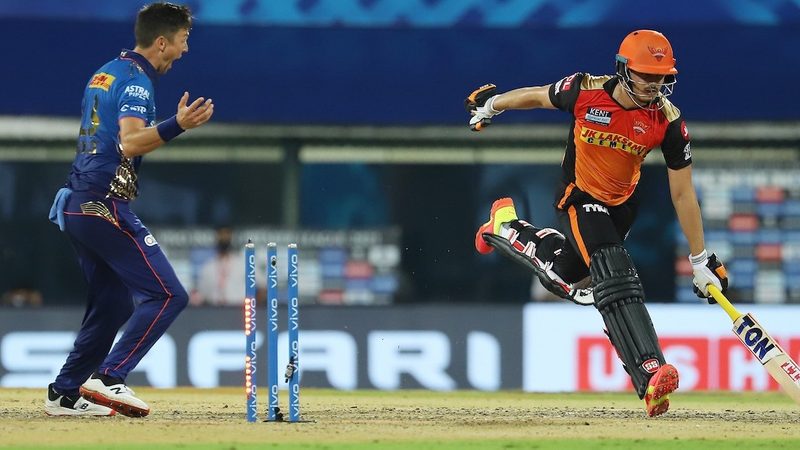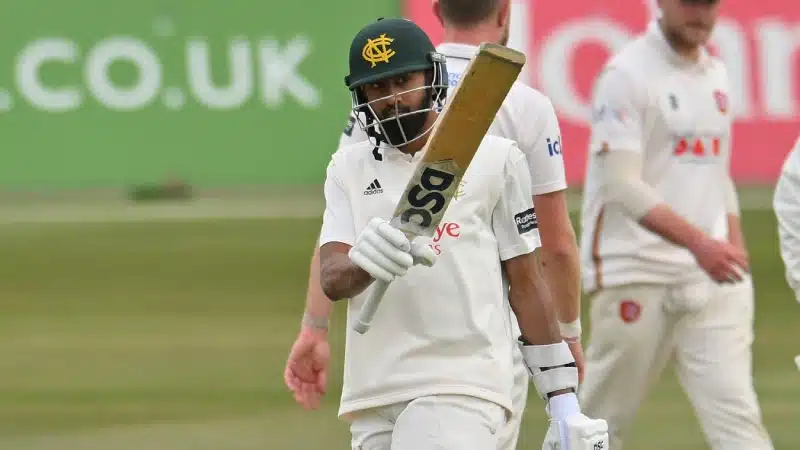
Rohit Sharma’s Team Mumbai piled further misery on Team Hyderabad by successfully managing to defend a middling total of 150 runs, beating the one-time Indian T20 League champions by 13 runs at Chennai’s MA Chidambaram Stadium on Saturday, April 17.
It was the same old story for Hyderabad, who made a blistering start through David Warner and Jonny Bairstow, but as the duo was dismissed, the middle order crumbled from 90/2 to 137 all-out. The duo, in fact, scored more runs than all of their teammates combined.
Mumbai had earlier posted 150/5, riding on the back of a late blitz by Kieron Pollard. The hard-hitting West Indian had scored 35 off just 22 balls. He later went on to concede just 10 runs in two overs as Hyderabad lost their third Indian T20 League game on the trot.
That being said, let’s take a look at some of the key stats from the game;
Kieron Pollard completes 200 sixes for Mumbai
Kieron Pollard walked in to bat when Mumbai were reeling on 98/3 in 14 overs. His unbeaten 35 guided Mumbai to 150, with his knock including one four and three sixes. With that, Pollard became the first player to hit 200 sixes for Team Mumbai. Overall, he became only the sixth player to cross the 200-six mark in the league.
| Most 6s for Mumbai in Indian T20 League | |
| Player | 6s |
| Kieron Pollard | 201 |
| Rohit Sharma | 166 |
| Hardik Pandya | 93 |
| Ambati Rayudu | 79 |
| Ishan Kishan | 52 |
While Pollard took his time against Hyderabad spinners, he was at his vicious best against pacers, hitting them for 27 runs at a strike rate of 168.75. While Mumbai were losing wickets at will, Pollard continued to cause damage. A whopping 67.35% of Mumbai’s runs in the last five overs (33/49) came through his bat.
Hyderabad’s poor start
Team Hyderabad endured their worst start in their Indian T20 League history. The team is yet to win a single game in three outings. Furthermore, their form in Chennai is even more worsening. A defeat on Saturday was their sixth defeat at the venue. They are yet to register a win there. Hyderabad have several issues to take care of. Since 2020, the team has won just four of their 13 run chases in the league while losing nine.
| Hyderabad's first three matches of Indian T20 League seasons | ||||||
| Year | Matches | Won | Loss | Tie - W | Tie - L | Win % |
| 2013 | 3 | 1 | 1 | 1 | 0 | 66.67% |
| 2014 | 3 | 1 | 2 | 0 | 0 | 33.33% |
| 2015 | 3 | 1 | 2 | 0 | 0 | 33.33% |
| 2016 | 3 | 1 | 2 | 0 | 0 | 33.33% |
| 2017 | 3 | 2 | 1 | 0 | 0 | 66.67% |
| 2018 | 3 | 3 | 0 | 0 | 0 | 100% |
| 2019 | 3 | 2 | 1 | 0 | 0 | 66.67% |
| 2020 | 3 | 1 | 2 | 0 | 0 | 33.33% |
| 2021 | 3 | 0 | 3 | 0 | 0 | 0% |
On the contrary, they have been rather successful in setting up a target since 2020. They have won four of the six matches where they have defended a target. Hyderabad’s efficiency in gathering runs in death overs was once against exposed against Mumbai. The team scored just 33 runs between 16-20 overs and lost five wickets. They had 54 dot balls against Mumbai which is equivalent to nine overs.
Boult and Chahar leading Mumbai’s charge
The likes of Trent Boult and Rahul Chahar led Mumbai’s bowling charge as both ended up with three wickets at their disposal. Chahar, in particular, skimmed through Hyderabad’s middle-order while Boult did the job at the tail-end. The leggie’s figure of 3/19 is now his second-best bowling spell in the Indian T20 League. He has now taken his wicket tally to seven wickets which the joint highest wickets in the league so far.
| Trent Boult vs Hyderabad in Chennai | |||||||||
| Overs | Runs | Balls | Wickets | Dots | 4s | 6s | Average | Economy | Balls/Bound |
| 1-6 | 20 | 12 | 0 | 7 | 3 | 1 | - | 10.00 | 3 |
| 16-20 | 8 | 10 | 3 | 5 | 1 | 0 | 2.66 | 4.80 | 10 |
Chahar bowled as many as 13 dot balls against Hyderabad, which is his joint-most dot balls in a spell in the league. Boult, on the other hand, was taken to cleaners in the opener overs, but the New Zealand quick made a brilliant comeback later in the game. His 3/28 is his fourth-best spell in the league now. Between the powerplay overs, Boult went for 10 runs per over. The figure dropped significantly as he bowled at an economy of 4.80 during the death overs.
Featured photo: Twitter / IPL




















